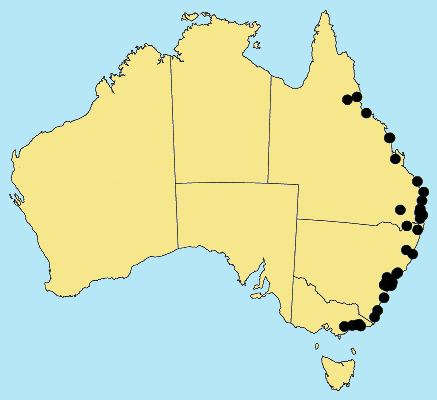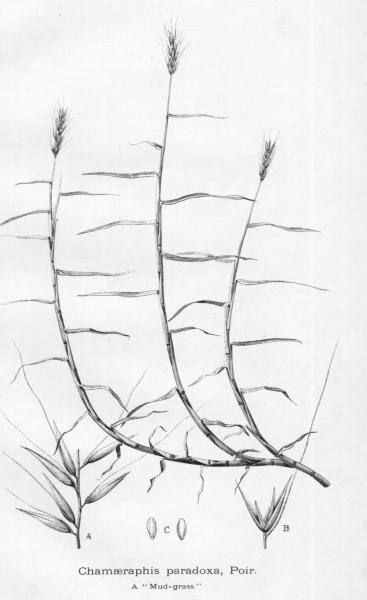Pseudoraphis paradoxa (R.Br.) Pilger. Notizbl.
Bot. Gart. Berlin-Dahlem 10: 210 (1928).
Classification.
(GPWG 2001) : Subfamily Panicoideae. Paniceae.
Basionym and/or
Replacement Name: Panicum
paradoxum R.Br., Prod. 193 (1810).
Type of Basionym or
Protologue Information: Australia,
Port Jackson: Brown (K iso).
Key references
(books and floras): [1878] G.Bentham, Flora Australiensis 7 (499 as Chamaerhaphis
paradoxa), [2002] D.Sharp & B.K.Simon, AusGrass, Grasses of
Australia, [2008] S.W.L.Jacobs, R.D.B.Walley & D.J.B.Wheeler, Grasses
of New South Wales (358).
Illustrations:
[1984] N.T.Burbidge. rev. S.W.L.Jacobs, Australian Grasses (225), [2008] S.W.L.Jacobs, R.D.B.Whalley
& D.J.B.Wheeler, Grasses of New South Wales, 4th edn (358).
Habit.
Perennial. Stolons present. Culms prostrate, 20–50 cm tall. Mid-culm nodes
glabrous. Ligule an eciliate membrane or a fringed membrane, a ciliolate
membrane, 0.8–1.5 mm long. Leaf-blades floating, 1–8 cm long, 2–6 mm wide.
Leaf-blade surface smooth or scaberulous.
Inflorescence.
Inflorescence solid, a panicle. Racemes appressed, 1–15 cm long, bearing 1(–2)
fertile spikelets on each. Central inflorescence axis 3–8 cm long.
Spikelets.
Spikelets sessile. Fertile spikelets 2-flowered, the lower floret barren
(rarely male), the upper fertile, comprising 1 basal sterile florets,
comprising 1 fertile floret(s), without rachilla extension, lanceolate,
dorsally compressed, 7.5–11 mm long. Rhachilla internodes elongated below proximal
fertile floret.
Glumes. Glumes
dissimilar, thinner than fertile lemma. Lower glume oblate, hyaline, without
keels, 0 -nerved. Upper glume elliptic, 7.5–11 mm long, membranous, without
keels, 13–19 -nerved. Upper glume surface smooth or asperulous. Florets.
Basal sterile florets 1, male, with palea. Lemma of lower sterile floret 100 %
of length of spikelet, membranous, 13–19 -nerved. Fertile florets female.
Fertile lemma 3.3–3.7
mm long, without keel, 5 -nerved. Palea without keels. Anthers 3. Grain 2 mm long.
Continental
Distribution: Australasia.
Australian
Distribution: Queensland, New South Wales, Victoria.
Queensland:
Moreton, North Kennedy, Port Curtis, Wide
Bay, South Kennedy, Darling Downs. New South Wales:
North Coast,
Central Coast. Victoria:
East Gippsland, Gippsland Plain.
Notes.
The relationship between P. paradoxa and P. spinescens is not
clearly understood, though the two seem to be distinct. In Ceylon, P.
spinescens var. depauperata (Nees) Bor is applied to specimens with
a contracted inflorescence.
In tropical and
subtropical wet sclerophyll forests, temperate wet sclerophyll forests, and dry
sclerophyll forests.





